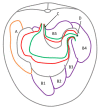Equine Stomach Development in the Fetal Period: An Anatomical, Topographical, and Morphometric Study
- PMID: 36359095
- PMCID: PMC9658733
- DOI: 10.3390/ani12212966
Equine Stomach Development in the Fetal Period: An Anatomical, Topographical, and Morphometric Study
Abstract
Studies of equine stomach prenatal development are very rare, and descriptions usually focus on the processes taking place in the embryonic period. Only general information about gastric organogenesis in the fetal period is available in embryology textbooks on domestic mammals. The material for our study included twenty half-breed horse fetuses divided into three age groups on the basis of known fetal age (verified using the CRL method). Our study consists of the topographical, morphological, and morphometrical description of stomach development between the 4th and 11th months of gestation. Even though the skeletotopy, syntopy, and holotopy of the stomach in the fetal period seems to be relatively unchanged, the organ shape and the proportions between its anatomical parts differed in fetuses from the three age groups. The achieved results were statistically elaborated to estimate the dynamics of the stomach shape. This can be described as changing from medium-wide to wide and from slightly bent to sharply bent. A nonlinear correlation of all metric values with CRL in all age groups was observed. A positive allometric growth rate of different intensity was seen in all metric parameters. All the values increased as the fetal period progressed. Only the parietal surface growth rate gradually changed from strongly positive allometric in the first age group to strongly negative allometric in the third age group. A difference between the non-glandular and glandular mucosa of the stomach was visible in the first group. Development of a well-distinguishable plicated edge margin began in the second age group together with gastric pits and gastric areas. The third age group showed a well-developed gastric groove and angular incisura.
Keywords: anatomy; development; equine; fetal period; morphometry; stomach; topography.
Conflict of interest statement
Neither of the authors has any financial or personal relationships that could inappropriately influence or bias the content of the paper.
Figures
















Similar articles
-
Equine Stomach Development in the Foetal Period of Prenatal Life-An Immunohistochemical Study.Animals (Basel). 2022 Dec 31;13(1):161. doi: 10.3390/ani13010161. Animals (Basel). 2022. PMID: 36611768 Free PMC article.
-
Equine Stomach Development in the Foetal Period of Prenatal Life-A Histological and Histometric Study.Animals (Basel). 2022 Nov 6;12(21):3047. doi: 10.3390/ani12213047. Animals (Basel). 2022. PMID: 36359171 Free PMC article.
-
Morphometric and immunohistochemical study of the abomasum of red deer during prenatal development.J Anat. 2007 Sep;211(3):376-86. doi: 10.1111/j.1469-7580.2007.00772.x. Epub 2007 Jul 21. J Anat. 2007. PMID: 17645454 Free PMC article.
-
The development of stomach during the fetal period.Surg Radiol Anat. 2006 Oct;28(5):438-46. doi: 10.1007/s00276-006-0124-x. Epub 2006 Aug 12. Surg Radiol Anat. 2006. PMID: 16906359
-
Factors involved in the 'rotation' of the human embryonic stomach around its longitudinal axis: computer-assisted morphometric analysis.J Anat. 1999 Jan;194 ( Pt 1)(Pt 1):61-9. doi: 10.1046/j.1469-7580.1999.19410061.x. J Anat. 1999. PMID: 10227667 Free PMC article.
Cited by
-
Equine Stomach Development in the Foetal Period of Prenatal Life-An Immunohistochemical Study.Animals (Basel). 2022 Dec 31;13(1):161. doi: 10.3390/ani13010161. Animals (Basel). 2022. PMID: 36611768 Free PMC article.
-
Equine Stomach Development in the Foetal Period of Prenatal Life-A Histological and Histometric Study.Animals (Basel). 2022 Nov 6;12(21):3047. doi: 10.3390/ani12213047. Animals (Basel). 2022. PMID: 36359171 Free PMC article.
References
LinkOut - more resources
Full Text Sources

